



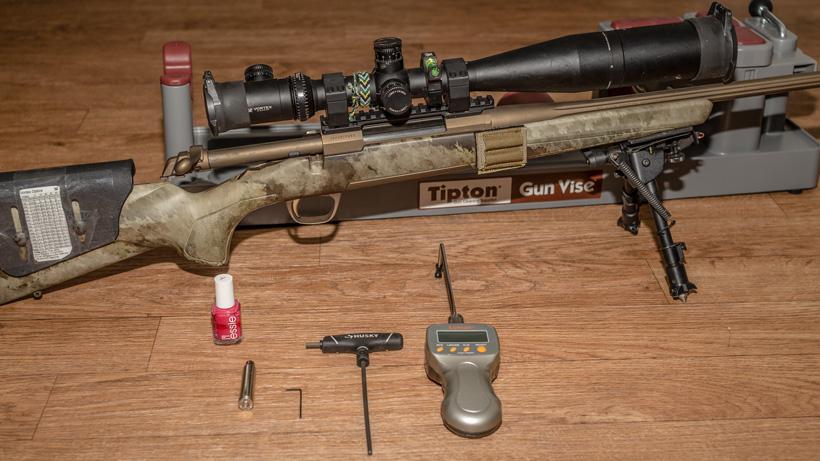
* Note: Use an empty rifle cartridge when testing.
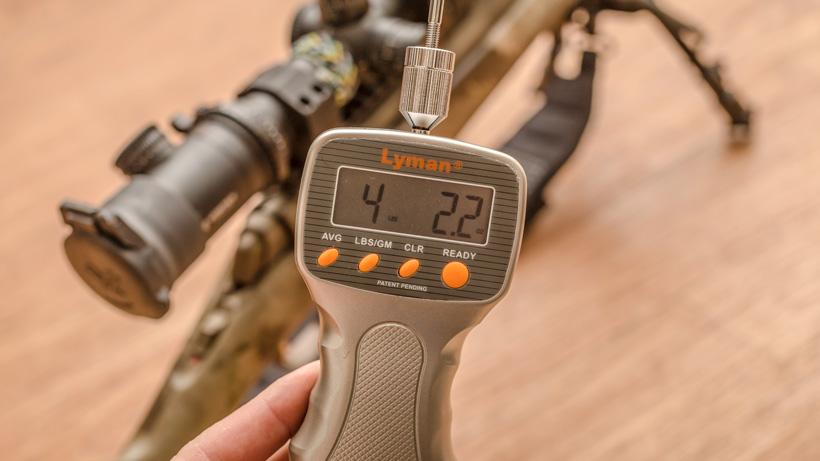
The stock trigger pull was 4 lbs. 2.2 oz. on my Browning X-Bolt.
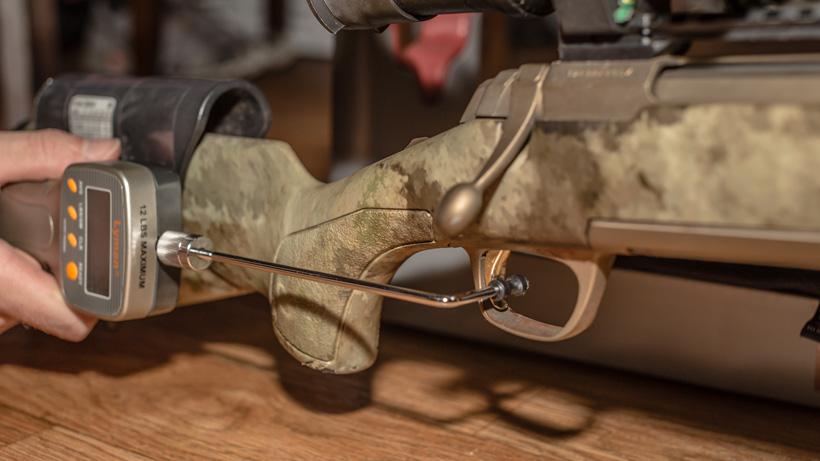
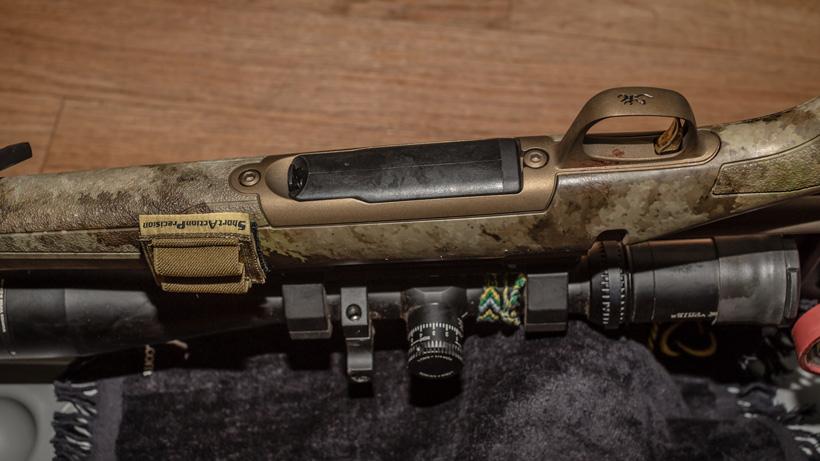
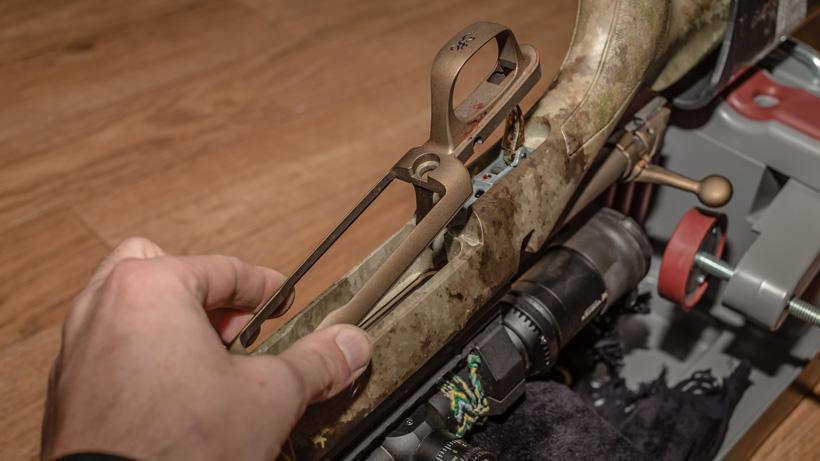
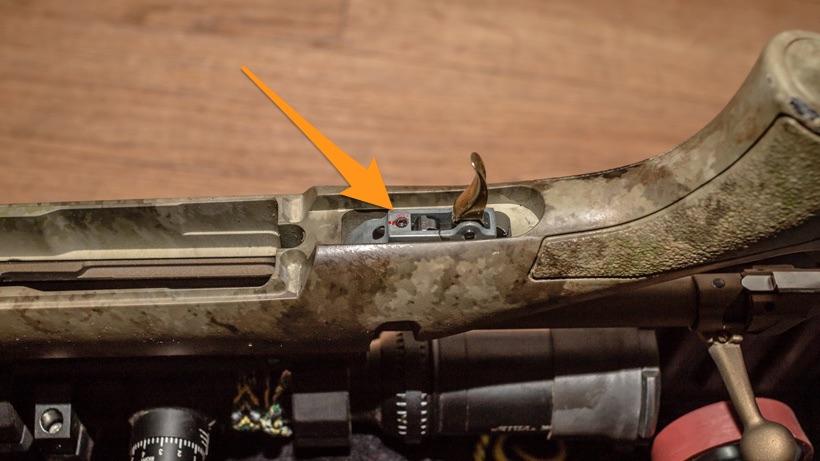

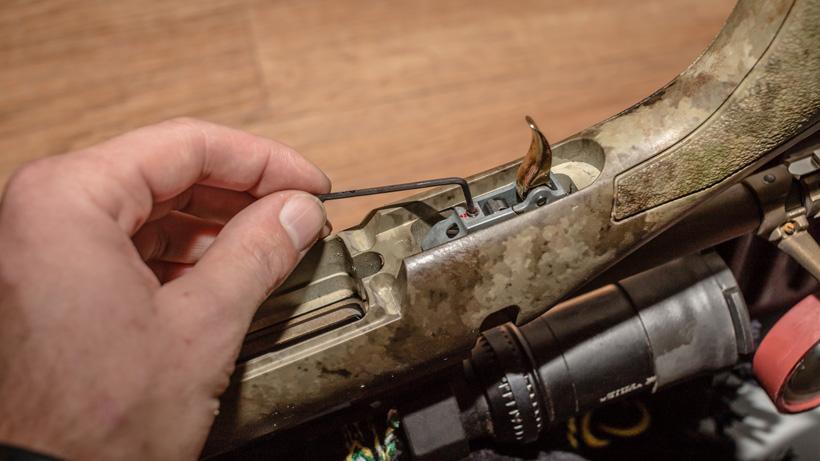
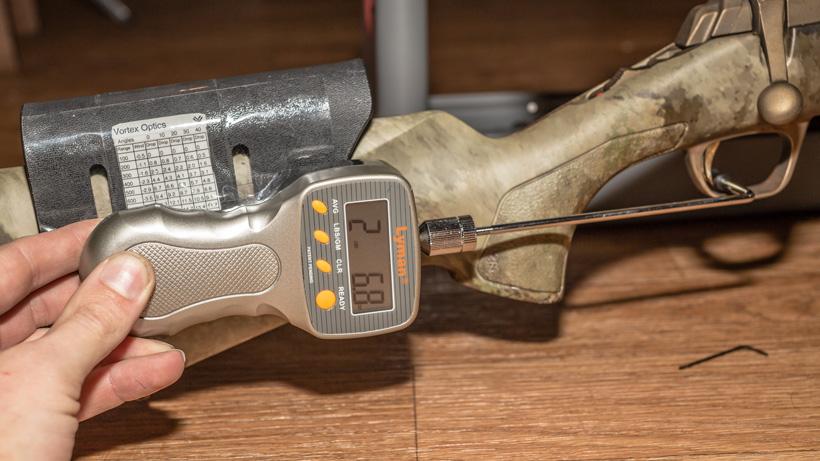
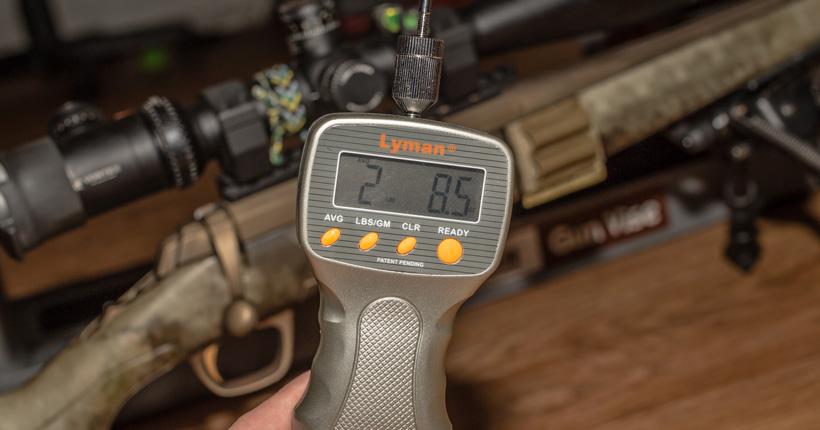
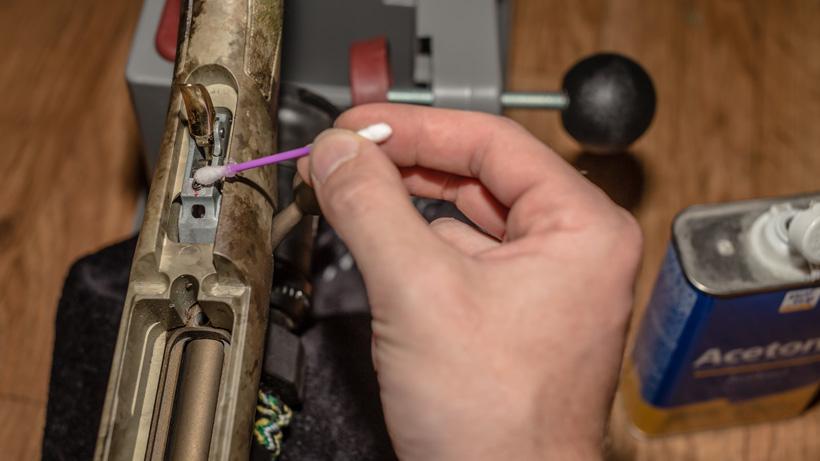

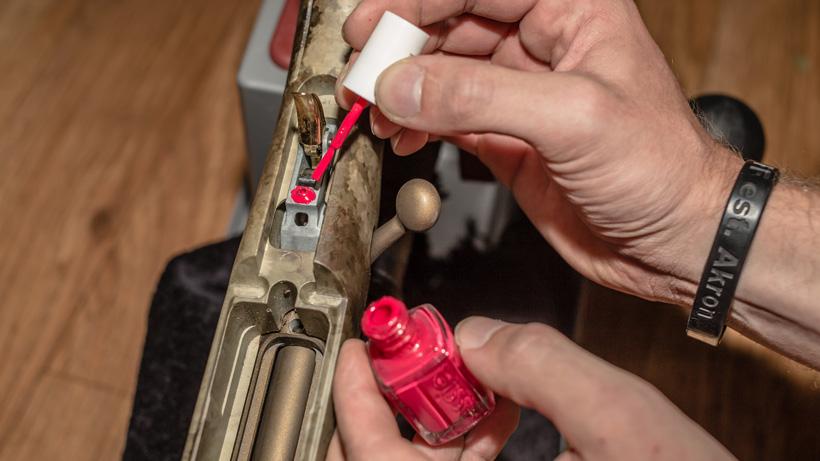
Precision. It’s what we all strive for and, ultimately, leads to success during the fall. Getting to a high level of precision not only takes time, but it also takes knowledge of your weapon and a commitment to perfect practice.
I know a lot great rifle shooters; my dad has probably been the biggest influence on my level of dedication to accuracy and precision no matter what weapon I’m holding. Yet, anyone who is skilled at shooting has one thing in common and that is trigger pull control.
One of the best explanations of trigger pull was by my dad. He explained it to me in terms of the relation of how much the gun weighs to how much trigger pull you have. For example, if you have a lightweight gun that weighs 7 lbs and your trigger pull is set at 5 lbs, your trigger pull is over 70% of the weight of the rifle. This means that when you are applying the required pull to make your trigger break, you have an increased likelihood of making the gun move since you are almost pulling back the same weight as the gun.
Let’s face it, stock rifles are meant to have a heavy trigger for safety reasons. No rifle manufacturer wants an accidental discharge, which means that their rifles are set up in the factory to have a heavy trigger. Fortunately, more and more rifle manufacturers are building their stock rifles with an adjustable trigger to accommodate those of us who want to tweak it to our own shooting abilities.
Adjustable triggers allow the user to manipulate the amount of force (pounds) it takes for the trigger to break and the shot to go off. A quality rifle doesn’t always need a new $250 trigger job. Instead, it may only need to be lightened in order for you to see greatly improved groups.
It’s all about accuracy. Rifle triggers are meant to be squeezed very slowly. Accurate and precise shot placement on an animal is extremely important so you shouldn’t rush the shot process and pull the trigger to make the gun go off. That will lead to your bullet impacting in a different place.
While shooting a rifle, you don't want to know when your rifle goes off. Just like in archery, anticipating the shot leads to flinching. Instead of pulling the trigger back suddenly, just gradually add pressure to the trigger while keeping your crosshairs on the animal. Eventually, the rifle will fire with a surprised break.
Heavy triggers can also cause you to flinch and are more difficult to achieve a clean break. Most factory triggers are set at around 4 lbs and ones that have an adjustable trigger usually have a range of 3 to 5 lbs.
* Optional
As always, ensure the gun is unloaded whenever you're working on it. I am adjusting the trigger on my Browning X-Bolt Hell’s Canyon Speed rifle so your particular setup may be a little different.
I like to start off the process by first testing the stock trigger poundage. You'll want to use a very accurate spring or digital scale for trigger adjustments. I prefer to use a empty rifle casing in the chamber for test firing during this trigger process rather than dry firing the gun. I’m using a Lyman Electronic Digital Pull Gauge for determining the trigger pull weight. The scale is very simple to use. Simply activate the unit by pressing the “Ready” button. Next, place the black plastic roller just in front of the trigger, but do not touch it to the trigger. Now press the “Ready” button again; you’ll hear a loud beep that indicates the scale is ready.
It’s very important to keep a steady hand when getting trigger pull readings and to keep the trigger hook parallel with the bore of the gun. This is done to prevent incorrect readings. Next, you'll pull the gauge slowly backwards until the trigger releases. The Lyman scale will show you the trigger pull in pounds and ounces.
The Lyman scale also automatically calculates an average pull reading. Just repeat the step at least five times and then push the “AVG” button.
Start by removing the magazine and unscrew the bottom two bolts. I prefer to flip the rifle over and place it on a vice for simplicity.
Next, lift the metal trigger guard out of the stock.
The trigger adjustment screw is located just in front of the trigger. Depending on your rifle, the screw may have some sort of sealant on it.
To increase the weight of the trigger pull, turn the adjustment screw in a clockwise direction using a 2mm Allen wrench. To decrease the weight of the trigger pull, turn the adjustment screw in a counterclockwise direction. Note: If the trigger pull is set too heavy, the trigger cannot be pulled and must be re-adjusted. Turn the screw counterclockwise until the trigger can be pulled.
Now you will want to repeat the process you did in step one until you get the trigger pull that you desire. I prefer setting my hunting rifle up between 2.75 and 3 lbs. This poundage is light enough to prevent you from jerking the trigger, but also heavy enough so you can still feel the trigger when the temperatures drop and your hands are cold.
Keep in mind that the lightest trigger possible is not always best for hunting. Some people can shoot that way, but remember how much things change when you are in a hunting situation. If you're going with a 2 lb trigger, be sure to practice in rain, wind and cold conditions.
The Lyman Digital Pull Gauge has a great averaging function on it. I did a series of five test pulls and then got an average trigger pull reading of 2 lbs 8.5 oz which I am very happy with. To ensure you like the feel of the trigger weight, you should do another round of practice shots with an empty rifle cartridge. I do this by laying prone with a rear bag supporting my rifle and sqeezing the the trigger to simulate a hunting situation. If you feel the trigger is too light or heavy, repeat the above steps.
When you're finished making the adjustment, now you'll need to apply nail polish to the trigger adjustment screw threads. The purpose of the nail polish is to prevent the screw from moving over time. Nail polish is preferred over Loctite Threadlocker Blue or superglue. I start this process by taking a Q-tip and apply a small amount of acetone to clean the threads and surrounding areas before applying nail polish. If there's one thing I've learned over the years while painting my bow, tripods, or other hunting accessories, it's that preparation when painting is everything.
Next apply a small amount of nail polish to the threads and surrounding area.
Replace the trigger guard back in the stock and reinstall the trigger guard bolts snugly.
Your rifle is now ready for increased hunting accuracy. To finish up this process, it's best to do another round of practice shots with an empty rifle cartridge like you did in Step 5. Sometimes it might be better to put the rifle away and practice with the trigger again tomorrow. That way you are starting fresh and are not convinced that the trigger pull is perfect. A day can make a big difference. If you feel the trigger weight is off... head back a few steps, scrape away the nail polish and adjust the trigger weight again.
Item | 2mm Allen Wrench |
|---|---|
Cost | NA |
Item | 4mm Allen Wrench |
Cost | NA |
Item | Tipton Gun Vice* |
Cost | $49.99 |
Item | Lyman ElectronicnttttDigital Pull Gauge |
Cost | $54.99 |
Item | Acetone bottle |
Cost | $8.99 |
Item | Q-tip |
Cost | NA |
Item | Nail Polish* |
Cost | NA |
Item | Empty rifle cartridge |
Cost | NA |
Item | Total |
Cost | $113.97 |
Item | Cost |
|---|---|
2mm Allen Wrench | NA |
4mm Allen Wrench | NA |
Tipton Gun Vice* | $49.99 |
Lyman ElectronicnttttDigital Pull Gauge | $54.99 |
Acetone bottle | $8.99 |
Q-tip | NA |
Nail Polish* | NA |
Empty rifle cartridge | NA |
Total | $113.97 |